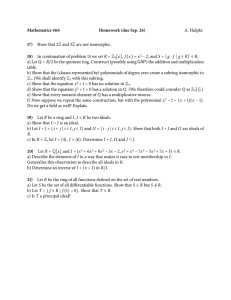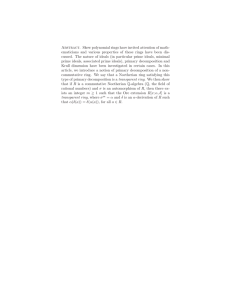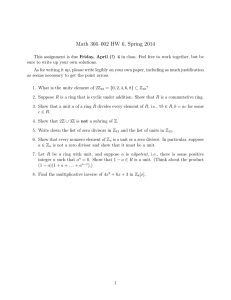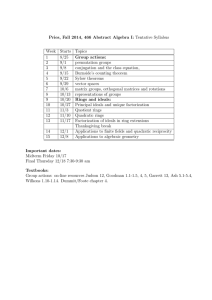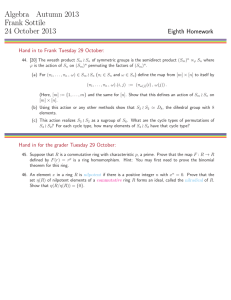chain conditions on symmetric elements1
advertisement
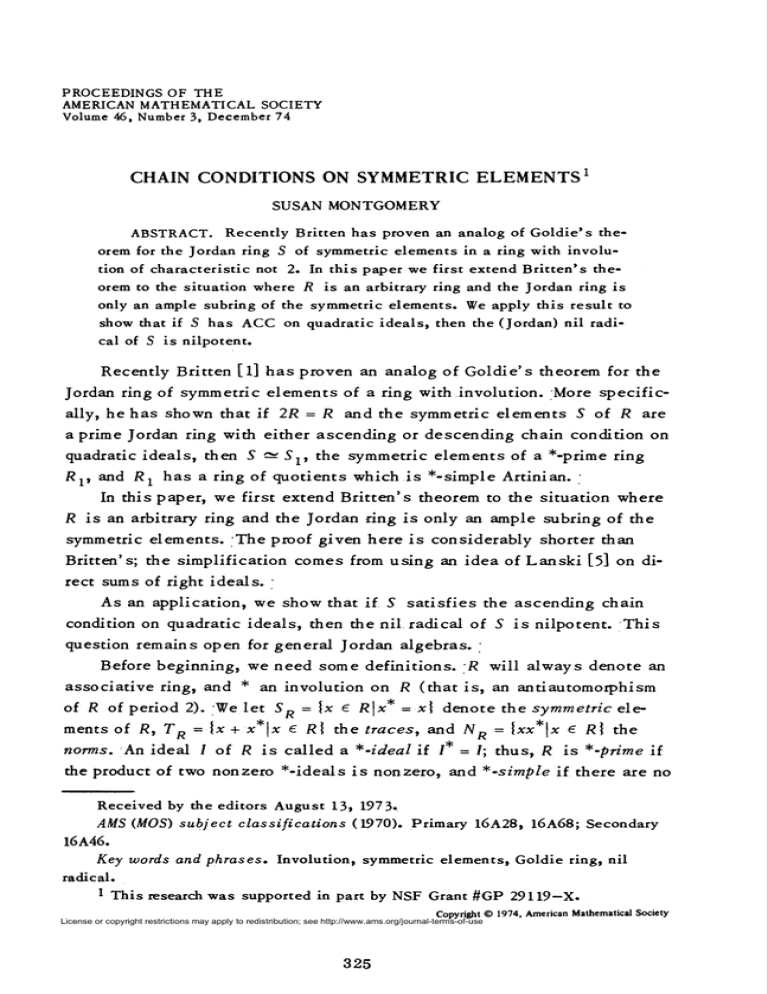
PROCEEDINGS OF THE
AMERICAN MATHEMATICAL SOCIETY
Volume 46, Number 3, December 74
CHAIN CONDITIONSON SYMMETRICELEMENTS1
SUSAN MONTGOMERY
ABSTRACT.
Recently
orem for the Jordan
ring
Britten
tion of characteristic
not
orem to the
where
only
situation
an ample
show that
subring
if S has
has
proven
S of symmetric
2. In this
paper
symmetric
ring
elements.
on quadratic
ideals,
of Goldie's
in a ring with
we first
R is an arbitrary
of the
ACC
an analog
elements
extend
Britten's
and the
Jordan
We apply
this
then
the-
involu-
the (Jordan)
thering
is
result
to
nil radi-
cal of S is nilpotent.
Recently
Jordan
Britten
ally, he has
shown
a prime Jordan
quadratic
Rj,
[l] has proven
ring of symmetric
then
has
an analog
S ^ Sj,
ascending
In this paper,
we first
extend
which
symmetric
elements.
the simplification
The proof
given
comes
for the
More specificS of R are
chain
elements
is *-simple
Britten's
ring and the Jordan
Britten's;
theorem
elements
or descending
the symmetric
a ring of quotients
R is an arbitrary
of Goldie's
of a ring with involution.
that if 2R = R and the symmetric
ring with either
ideals,
and Rj
elements
condition
of a *-prime
ring
Artinian.
theorem
to the situation
ring is only an ample
subring
here
shorter
is considerably
from using
on
an idea
of Lanski
where
of the
than
[5] on di-
rect sums of right ideals.
As an application,
condition
on quadratic
question
remains
Before
associative
open
beginning,
ring,
of R of period
and
we show that
ideals,
then
for general
we need
if S satisfies
the nil radical
Jordan
some
2). We let
An ideal
the product
/ of R is called
of two nonzero
*-ideals
a *-ideal
is,
= x\ denote
ments of R, TR = \x + x \x £ R] the traces,
norms.
of S is nilpotent.
R will always
on R (that
SR = \x £ R\x
chain
This
algebras.
definitions.
* an involution
the ascending
the symmetric
and NR = \xx
ii I
is nonzero,
denote
an
an antiautomorphism
= I; thus,
ele-
\x £ R\ the
R is *-prime
and ^-simple
if there
if
are no
Received by the editors August 13, 1973.
AMS iMOS) subject classifications
(1970). Primary 16A28, 16A68; Secondary
16A46.
Key words
and phrases.
Involution,
symmetric
elements,
Goldie
ring,
nil
radical.
1 This research was supported
in part by NSF Grant #GP 29119—X.
Copyright © 1974, American Mathematical Society
License or copyright restrictions may apply to redistribution; see http://www.ams.org/journal-terms-of-use
325
326
SUSAN MONTGOMERY
proper
*-ideals.
it is easy
We say
to see that
In what follows,
/
R is semiprime
a *-prime
/
will be an additive
if R contains
no nilpotent
ideals;
Jordan
that is,
ring is semiprime.
will denote
a special
quadratic
ring;
of R closed under the quadratic
operator
2
xU = yxy and the binary composition
x . A Jordan subring
/ of SR is
y
*
called ample if it contains
all norms and traces and if xjx
C /, for all x £
R. An additive
subgroup
subgroup
We abbreviate
Recall
that
R has
no infinite
Risa
We begin
/ C / isa
the ascending
right
direct
Goldie
sums
with an easy
Lemma
1. Let
quadratic
ideal of / if JU. C /.
(descending)
chain
ring if R has
of right
lemma.
condition
ACC on right
by ACC (DCC).
annihilators
and
ideals.
Part
R be a semiprime
(ii) is part of Britten's
ring with
*, and
Lemma
J an ample
A [l].
Jordan
subring of S. Then:
(i) If a £ J with a]a = 0, then a = 0.
(ii) // / is a right {left) ideal of R with I (1 / = 0, then Q = \x + x*\
x £ 1} is a quadratic ideal of J.
Proof,
axax
(i)
Since
a £ J and
a = 0. On the other
hand,
axa = —ax a, and so axaxa
is a nil right
R has
ideal
a nilpotent
(ii)
Say that
0. Thus,
ideal
theorem
Theorem
1. Let
sums
of quadratic
index.
(a contradiction),
ideal,
£ J and
in /, a*Ja
xax
£ J for all
unless
and choose
a*saja*sa
Theorem
R be a *-prime
ideals,
{ax)
By a theorem
= 0; that is, aR
[3, p. l],
a = 0.
a £ I. Then
a]a
that
JU
C / n/
= 0. Since
« Ç Q, fot all
=
s
a £ I.
1 of Britten.
ring and J ample.
then
gives
of Levitzki
= 0. By (i), a*sa
= 0. It now follows
extends
x £ R. Thus,
£ J so a{x + x )a = 0. This
= 0, all x £ R. But then
/ is a right
The first
direct
is ample,
of R of bounded
if s £ ], a*sa
was arbitrary
/
x + x
R has no infinite
If J has no infinite
direct
sums
of right
or left ideals.
Proof.
Assume
sums of quadratic
ideals
whose
that
ideals
the result
is false,
that is, / has no infinite
but, in R, M = \T. ! is an infinite
direct
collection
of right
tT¡ by an appropriate
subset)
sum is direct.
We claim
that we may assume
that any finite
sum of ideals
(by replacing
in % intersects
/ only in (0).
For,
\Tn, Tn ., • • • }. Now, if 111= tIÎj fails, there exists
let %. =
a finite sum Sj =
T,1 +T, 2 + --- + T «1 —.1 such that S.1 n /■>^ (0). Then try• /Tln\ = \T nY ,•••!.
If 1ÍÍ fails, there must be a finite sum Sn = T
+ — + T
, with
n j
'
2
n\
License or copyright restrictions may apply to redistribution; see http://www.ams.org/journal-terms-of-use
722-1
327
CHAIN CONDITIONS ON SYMMETRIC ELEMENTS
Lfl/
4 (0). Repeat the argument: if )1I fails, there is some Sk . 4
+ ■•• + T
, with S, ,nj4
(0). But if S, exists for all k, then
T
the set
\S, C\J\
is an infinite
direct
sum, a contradiction.
finite
sum of right
set of quadratic
Thus,
ideals
for some
intersects
ideals
of /
which
form a
k, it must be that in IK
/ nontrivially.
nk
is the desired
%
, no
sub-
set.
Now for each T. el,
dratic ideal of/. Since/
consider
Q . = \x + x*\x £ T. i. By Lemma 1, Q . is a qua-
has no infinite
direct
set \Qj, • • • , Q I which is dependent:
a.
= x.l + x*l fot
1l
nite direct
x.l £ T.7 and let
sum in {Q
fö„+i» ••• ,Qml
sums of quadratic
ideals,
there is a finite
for some q. £ Q., not all zero, Sç. = 0. Write
a = Sx. 7 £ £"_.T..
Z —1
,, • • • Î, there
must
Since
I
be another
finite
there
is no infi-
dependent
set
Say that 1pj = 0 for not all p. £ Q. zero. Let p. = y. +
y* and b = Ey/ ;. e" Sm
/;
n +1,T..7 Then a + a* = b + b* = 0:' thus a and b ate skew
and are nonzero
by independence
of the
T,.
Now let r £ R. Then ore + br*a £ (ST. + ST ) O / = (0), and so are =
-fJ7-*a. But then arb £ {1T{) n{2T ) = (0) by the directness of \T k\. Thus,
izrt3= 0, all r £ R. But then {RaR){RbR) =0, and RaR and RbR ate *-ideals
of R since
a and
a contradiction.
b ate skew.
Thus,
Now if 17 is a subset
annihilator
ann.fi
it, a properly
B . = ann;A .. Then
an infinite
and that
that
R be *-prime.
of right
the
ideals.
of U. If
annihilators
in R, let
B . are a properly
descending
A . = ann B ..
7
r
The next lemma is also part of Britten's
Lemma 2. Let
sum of right
the left annihilator
chain
to verify
of R, a = 0, or b = 0,
direct
ann U = \x £ R\ Ux = 0], the right
denotes
ascending
it is easy
chain of left annihilators
have
of R, we write
of U. Similarly,
Aj C A2 C • • •
By the *-primeness
R cannot
Then
7
Lemma
A.
if C is the right {left)
annihilator
of a nonzero ideal of R, C ft) C* = 0.
Proof. Let / be the ideal of R, so that IC = 0. Then C7 is a right ideal
of R with {CI)
- 0, and so CI = 0 since
R is semiprime.
Applying
have I*C* = 0 and thus (/ + 1*){C O C*) = 0. Since R{C nC*)R
of R, we must have
C DC
We are now able
plification
of his
=0
to extend
since
*, we
is a *-ideal
R is *-prime.
Britten's
Theorem
4. The argument
is a sim-
argument.
Theorem 2. Let R be *-prime and J ample. If J has ACC or DCC on
quadratic
Proof.
ideals,
then
If / has
R is a Goldie
ring.
ACC or DCC on quadratic
ideals,
License or copyright restrictions may apply to redistribution; see http://www.ams.org/journal-terms-of-use
then it is easy
to see
328
SUSAN MONTGOMERY
that
/ has no infinite
it suffices
We first
treat
not Goldie,
right
direct
to show that
let
sums
of quadratic
R satisfies
the case
ideals.
ACC on right
when
/ has
Thus,
ACC on quadratic
A. C iá, C • •'•'C A. C • •« be a proper
annihilators
in R, and let
by Theorem
annihilators.
ideals.
If R is
ascending
B . be the corresponding
1,
;
chain
descending
of
chain
of left annihilators.
First
assume
that
we may as well assume
an ascending
n/
chain
C5
A . DJ 4 0 for some
that
of quadratic
A
= • • • , We claim
i. Since
A . n / 4 0 for all
ideals
that this gives
the
i. Then
A . ate ascending,
\A . D J]
of /, 7 so for some
a contradiction.
is
m, A 777777
n J = A
For,
choose
,
+ 1
a £ A O
/ and y' £ A772+ ,.
Then y
a + ay*
£ A 777+1. D J = A772'D /, and so 0 =
1
J
*
B 777{ya
+ ay*)
= B mJ ya, ' since
J
J
S 777772
A
, 7^0, and a £ J"_' C S, a = 0 byI Lemma 2. Thus Am n / = 0. ■
<2- be given
that
1. Since
a—a
a + a* £ Q
xm
=-{a—a
777
that a is skew.
is, ' (R
Q. ate ascending,
, = Q
, so
x m1
each
any
.A
772+ 1
y £ A
But then
for some
Aa = 0. As above,
2. Then
this
'
contradicts
m,
the
eives
&
Q
=
a £ A 772+1'.,
a mm £ A .
So we may'
assume
ay* + ya* = ay* — ya £
B 777+ 1. ay*
= 0 = B777+ ,ya
'
1-7
777+ /
A ., let
a + a* = a mm1+ a* , tot some
+ l
Now choose
A 777+ ,1 = A 777', which
'
the
)* £ A 777+7'., 4 A m' , and is skew.
777
A 777+ ,2 n / = 0,» so ay*
= ya.
J
J
Thus,
A . n / = 0, for all ¿. For
We claim that A777+ ,1 = A777. For,' if not,' choose
a i A 777. Then
'
assume
as in Lemma
Q
x 777+ 1,=•••.
That
{B 777A 777+1,)a = 0. Since
+ 1'
We may therefore
Thus,
a £ A 777 = ann r R 777. Thus
since
a £ A 777+ ,.1
o = 0,» a contradiction.
A ,. being t> a proper
r
r
chain.
The proof for DCC is very similar; if B . n / = 0 for all i, get the Q.' s
as above.
again
have
assume
chain
Then
we can choose
y*a = ay, so a{B
that
a skew in B 772+1',, not in fi 777+¿,.
A
B . O / ^ 0, for some
of quadratic
1
ideals,
'
A = 0 and
¿. But the
so for some
may assume
ß
see that a(S
A .) = 0,' so a = 0.
772 777+2
7
O / 4 0. But then,
772
We are now able
Corollary
1. Let
to extend
'
Britten's
J be an ample
a = 0 as before.
1/5.0 /J
m,' B 772 n/
choosing
6
main
subring
to an ample
Proof.
Let
as [2, Lemma
P{R)
Jordan
denote
subring
J.
l], P{R) H / Ç P{J),
the prime
777+ 1,
»J
n/
we may
descending
= • • • and we
C\ J and y £ B , we
.
.
'
m'
theorem:
of SR, where
of a *-prime
the prime radical
Thus,
are a proper
= ß
a £ B
*. If J is prime and has ACC or DCC on quadratic
morphic
If y
£ B m1 , we
J
ideals,
Goldie
of R. Then
radical
of /.
R is a ring with
then
J is iso-
ring
Rj.
by the same proof
But since
/ is
prime, P{J) = 0; thus, P{R) D / = 0. Let Rj = R/P{R); Rj is semiprime.
Now
/,,
/j
the image of / in Rj, is isomorphic
to /
since
License or copyright restrictions may apply to redistribution; see http://www.ams.org/journal-terms-of-use
P{R) HJf = 0. Also
CHAIN CONDITIONSON SYMMETRICELEMENTS
is ample
since
/ is (R,
It remains
has
an induced
only to show that
Rj
involution
is actually
since
329
P{R) * = P{R)).
*-prime
(since
then
Rl
Goldie follows from Theorem 2). Say AB =0, where A, B ate 4 0 *-ideals of
R. Then A nj 4 0 (since if A O / = 0, a + a* = 0=o*a = a2, for
all a £ A, and R would contain a nilpotent ideal).
Similarly, B CiJ 4 0. But
AH/
=0,
and fin/
are ideals
of /, and {A ^DUgf^j
contradicting
/ being
prime.
Since
R.
of quotients
in fact
is a *-prime
A which
A is *-simple
/ has a Jordan
Goldie
ring,
by Goldie's
is semisimple
Artinian.
(see
Theorem
Britten's
theorem
Rj
It is not difficult
has
a ring
to see that
5). We can therefore
show that
ring of quotients.
Corollary 2. Let J, R, J., and R. be as in Corollary 1. Then J has a
Jordan
ring of quotients
Q(J).
If A is the associative
ring of quotients
for
Rj, then Q{J) ~ Q{JA is an ample subring of SA, and Q{SR ) = SA. When
2R = R, Q{J) is a simple Jordan ring.
Proof.
Using
every regular
Corollary
element
that rx - 0 for some x £ R,.
-x*,
so *
= -***
1, we may work entirely
of / is regular
£ J.
of r is nil of index
tradiction).
Thus,
x U = 0, x
is ample
ment of / is regular
The fact that
=0,
whenever
4.5],
which
that
and say
so x + x* = 0. Then x =
=0.
But this
xr = 0 implies
R has
We claim
r £ J, regular,
2, and so R, contains
x = 0. Similarly,
We can now apply [7, Theorem
and Q{J,)
in R,.
For let
Then {x + x*)U
Since
annihilator
S,,
in R..
says
that the right
a nilpotent
ideal
(a con-
x = 0.
states
exactly
a ring of quotients
that
Q(JiR) =
A and every
ele-
in R.
when
2R = R, (?(/)
— S . is simple
follows
from a theorem
of Herstein [3, Theorem 2.6]..
Having
extended
apply them to study
the Jordan
radical
ring
homomorphic
As in Corollary
P{J)
S, since
the (Jordan)
the symmetric
to arbitrary
of S. Let
1, P{R)
prime
elements
N{J)
characteristic,
denote
we now
the nil radical
will be the (associative)
radical
of /.
of
prime
We work with./,
might not be preserved
under
images.
Lemma 3. Let
R be a *-prime
on quadratic ideals.
Proof.
results
the nil radical
/.
of R, and
rather than
Britten's
Since
ring in which
J has
either
ACC or DCC
Then N{J) =0.
/ is ample and N{J) is an ideal
of /, N{J) is a core ideal
License or copyright restrictions may apply to redistribution; see http://www.ams.org/journal-terms-of-use
330
SUSAN MONTGOMERY
of S {tot details
associative
see [6, p. 387]).
*-ideal
Thus,
B of R such
if N{J) 4 0, there
that the core
exists
KAB) Ç N{J),
a nonzero
where
KAB) =
\b+ b* + Se. r3*|è, b. £ B}[6, Corollary, p 387]. We claim that B must
contain
a nonzero
0, or b* = -h,
is nil.
Then
nil right
ideal.
If KAB) = 0, this
is trivial;
tot all b £ B. But then also bb* = -h
We may therefore
x" = 0, x"~
assume
4 0 for some
that
KAB) 4 0. Choose
72, so letting
for b + b* =
=0, and so B itself
x £ KAB),
y = xn~
we have
x 4 0.
y
=0,
y 4 0. Now for any b £ B, yb + b*y £ XAB) Ç N{J), and so for some k,
{yb + b*y) = 0. Multiplying on the right by yb, we see {yb) + = 0; that is,
yB is nil.
By Theorem
subring
2, R is a Goldie
of R is nilpotent.
an ideal
in a semiprime
Thus,
ring,
ring.
By Lanski's
B contains
so is itself
theorem
a nilpotent
[A], any nil
ideal.
a semiprime
ring,
ring with
* such
But
B is
a contradiction.
Thus, N{J) = 0.
Theorem
3. Let
R be an associative
on quadratic
ideals.
Then
on quadratic
ideals,
then
Proof.
We will first
this by showing
For, consider
prime.
the nil radical
of S is nilpotent.
the nil radical
show that
of S equals
that if P is any proper
prime
ideal
S has ACC
If S has
the prime
N{S) = P{S) in either
the ring R = R/P OP* (possibly
that
situation.
of R, then
DCC
radical.
We do
P 2 N{S).
P DP* = P = P*); R is *-
Let / = S , the image of S in R. Then / is ample, has ACC or DCC
on quadratic
ideals,
and so N{J) = 0 by the lemma. But N{S) C N{J); thus,
N{S)ÇP DP* Ç P.
Now
P{R)
is the intersection
of all prime
ideals
of R, and so N{S) Ç
P{R). By [2, Theorem 3], P{R) n S = P{S). But N{S)Ç P{R) n S and N{S) D
P{S). Thus, N{S) = P{S).
In the case
ideal,
when
S has
ACC,
P{S)
will simply
be the maximal
nilpotent
so N{S) is nilpotent.
REFERENCES
1. Daniel
Britten,
On prime
Jordan
rings
HiR)
with
chain
condition,
J. Algebra
27(1973), 414-421.
2. T. S. Erickson
and S. Montgomery,
The prime
radical
in special
Jordan
rings,
Chicago,
111.,
Trans. Amer. Math. Soc. 156 (1971), 155-164. MR 43 #306.
3. I. N. Herstein,
Topics
in ring theory,
Univ.
of Chicago
Press,
1969. MR 42 #6018.
4. C. Lanski,
Nil subrings
of Goldie rings are nilpotent,
(1969), 904-907. MR 40 #1428.
License or copyright restrictions may apply to redistribution; see http://www.ams.org/journal-terms-of-use
Cañad. J. Math. 21
331
CHAIN CONDITIONS ON SYMMETRIC ELEMENTS
5. C. Lanski,
6. Kevin
Chain
McCrimmon,
conditions
in rings
On Herstein
with involution
s theorems
(to appear).
relating
Jordan
and associative
algebras, J. Algebra 13 (1969), 382-392. MR 40 #2721.
7. Susan
Montgomery,
Rings
of quotients
fora
class
of special
Jordan
rings,
J. Algebra 31 (1974), 154-165.
DEPARTMENT OF MATHEMATICS, UNIVERSITY OF SOUTHERN CALIFORNIA, LOS
ANGELES, CALIFORNIA 90007
License or copyright restrictions may apply to redistribution; see http://www.ams.org/journal-terms-of-use
